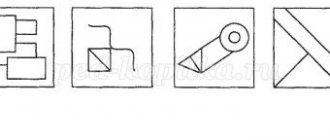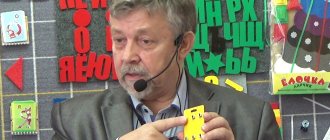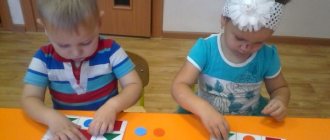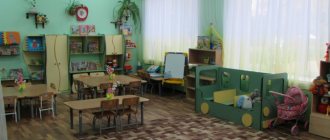There is a good joke. “Can you play the violin?” - “I don’t know, I haven’t tried it.” Is it possible to talk about Voskobovich’s educational games without the games themselves? Yes and no. To understand the game, you have to PLAY it. On the other hand, you need to understand IN THE NAME OF WHAT you need to play it.
Each phenomenon is based on either a theoretical proposition, which is then tested in practice (for example, a Waldorf garden), or practical experience, which is subsequently clothed in theory (for example, Nikitin).
The games that we will talk about today are definitely a movement from practice. But first, a little history.
In the beginning there were... children
The impetus for the invention of games was our own children. Here’s how Vyacheslav Voskobovich himself talks about it: “The era of perestroika. These are difficult times, but interesting in their own way. What was behind you by that time? Higher education – engineer-physicist. Passionate hobby: original song (wrote poetry, music, performed in concerts). A lyrical physicist, in a word. But children appear, and I turn into a normal, average parent. “I care” about the intellectual and creative health of my children. Shopping around toy stores makes you sad. There are games that our grandmothers' grandmothers played. And there is publicity around, all sorts of talk about alternative pedagogy. Fate brought us (how? – a separate topic) to these very “alternatives”, and off we went. Lectures, courses, lesson viewings, video materials. It would seem that after everything you have seen, heard, felt, take it (in those days this meant make it, today go and buy it) and use it. But I wanted to bring something of my own. And he brought it to such an extent that, in the end, it became a matter of life.”
How to use the toy
The Voskobovich square is a funny thing even for parents. In some ways it resembles origami, in some ways it resembles paper clamshell toys from our childhood. You can watch a master class on the Internet on the topic of using the toy, but I suggest using your own imagination first. So what can you do with a square?
- Try to count all triangles (even compound ones), as well as squares and rectangles. You will be surprised, but this is a really exciting activity.
- Try intuitive additions. Show your child how to fold a square to make a house, candy, triangle or small square, and then let the child try to fold something himself.
- Use different patterns to assemble ready-made square figures.
- Offer your child a game to develop their imagination - a banal guessing game. Take turns making some figures out of the square so that the other person can guess what happened.
- Be sure to invite your child to add up any symbols or letters that are familiar to him.
As soon as the toy becomes clear, it immediately turns into a favorite. Use recognizable elements to develop your baby's interest.
Voskobovich's first games
The first benefits appeared in the early 90s. The game “Geokont”, “Game Square” (now it is Voskobovich Square), “Folds”, “Color Clock” immediately attracted attention. By that time, Vyacheslav Voskobovich’s gaming practice was not limited only to the family; for several years he led children’s groups in educational games and literacy training.
With games and experience, they began to invite me to seminars. From the beginning in his native Leningrad, then to other cities.
There were more and more games - “Transparent Square”, “Transparent Number”, “Dominoes”, “Multiplication Planet”, the “Miracle Puzzles” series, “Math Baskets”... The first methodological fairy tales appeared.
Where did you get all this from?
I remember a funny incident of that time that happened in one of the kindergartens in Leningrad. Vyacheslav Voskobovich demonstrates to the manager his then “arsenal” of games. She likes everything, and she begins to offer her own options, “trying out” games for her children. And suddenly he asks the author-inventor: “Where did you get all this?” Vyacheslav Vadimovich was a little confused and couldn’t find anything better than to raise his finger up. As if to say: from there, from above, illumination, they say. The manager reacted to this in her own way. In a serious voice, she clarified: “From RONO?”
Jokes aside, but according to a survey by the St. Petersburg Education Committee, already in 1997, 90% of the city’s preschool institutions used Voskobovich’s educational games in their work.
Game Features
The period before 1998 can be called differently: constructive, exploratory, amateur, intuitive. Something else is important. During this period, the basic principles of building games were laid down, which can still be traced today. So, what is so interesting about Voskobovich’s games?
1. Structural elements.
In “Geokont” there is a dynamic “elastic band” as a means of construction, in “Voskobovich Square” there is rigidity and flexibility at the same time, in “Transparent Square” there is a transparent plate with an opaque part, in “Cord-entertainer” there is a cord and a block, etc. .
2. Wide age range of game participants.
The same game attracts children both three and seven years old, and sometimes even high school students. This is possible because it contains one- or two-step exercises for little ones and complex multi-step tasks for older children.
3. Multifunctionality.
With one game you can solve a large number of educational problems. Unnoticed by yourself, the baby masters numbers and letters; recognizes and remembers color, shape; trains fine motor skills of the hands; improves speech, thinking, attention, memory, imagination.
4. Versatility in relation to programs.
“Childhood”, “Development”, “Rainbow”... As practice has shown, games fit perfectly into these and other programs of educational institutions.
5. Creative potential.
Do you remember which game your child plays with the longest? Of course, with the one that gives him the opportunity to turn his “ideas” into reality. How many interesting things can be invented and made from the details of “Miracle Puzzles”, multi-colored “webs” of “Geokont”, “eternal origami” of “Voskobovich Square”: cars, planes, ships, butterflies and birds, knights and princesses - a whole fairy-tale world! Games give adults the opportunity to be creative.
6. Fairytale cut.
They say a good diamond requires cutting. Why not give the game a fairy-tale edge, for example? Children's interest in fairy tales is both an additional motivation and a model of mediated learning. Children enjoy playing not with squares, triangles and trapezoids, but with the Non-melting Ice of Lake Ice and the multi-colored webs of the Yuk Spider; they do not study fractions, but solve the secrets of the Miracle Flower together with Baby Geo. New, unusual and non-standard always attracts the attention of children and is better remembered.
Let's consider these general provisions using the example of two of the most famous games
"Geocont"
. People call it a “plate with nails.” Indeed, plastic nails are fixed on the plywood playing field, which are called “silver” in the fairy tale “Little Geo, Raven Meter and I, Uncle Slava.” “Spider webs” (multi-colored rubber bands) are stretched onto “silver” nails, and the contours of geometric shapes and object silhouettes are obtained. Kids create silhouettes based on what an adult shows, according to their own ideas, while older children create silhouettes based on a sample diagram and a verbal model (unlike similar games, a coordinate grid is applied to the “Geokont” playing field). Primary and secondary school students study geometry and prove theorems (moving to another plane helps to better understand the essence of the problem).
As a result of playing with “Geokont”, children develop motor skills of the hand and fingers, sensory abilities (mastering color, shape, size), mental processes (designing according to a verbal model, constructing symmetrical and asymmetrical figures, searching for and establishing patterns), and creativity.
“Voskobovich Square” (“Game Square”)
. This game has many “folk” names - “Maple Leaf”, “Klondike”, “Eternal Origami”. All this is essentially true. The “game square” consists of 32 rigid triangles glued to a flexible base on both sides at some distance from each other. Thanks to this design, the square can be easily transformed. Another name - “Transforming Square” - is not accidental, because both planar and three-dimensional figures are constructed from it.
“Square” in the fairy tale “The Mystery of Raven Meter” comes to life and turns into images: a house, a mouse, a hedgehog, a shoe, an airplane, a kitten.
Two-year-old children, with the help of an adult, put together a house with a red or green roof and a piece of candy. Older children master the design algorithm, find geometric shapes hidden in the “house,” and come up with their own object silhouettes.
A square can be cut in a certain way. For example, a cross cut gives unusual three-dimensional shapes. Games with parts of the Square are possible (for example, raise the left or right corner) - a kind of finger theater.
Games with the “Voskobovich Square” develop fine motor skills of the hands, spatial thinking, sensory abilities, thought processes, design skills, and creativity.
1998
This year has been a milestone in many ways and will be remembered for several events. Firstly, default. But this is not the topic of our conversation. We survived, for which we congratulated ourselves.
Secondly, at the Moscow exhibition, Voskobovich’s game “Miracle Crosses 2” received the “Best Product of the Exhibition” prize. Subsequently, the games repeatedly became laureates and diploma winners at various exhibitions and competitions for the originality and uniqueness of the products.
Thirdly, a meeting with Nikitin in his famous house. Fourthly, the invention of gaming educational complexes called “Igrovisor” and the carpet printer “Larchik”. Fifthly, the creation of the first version of the “Fairy Tale Mazes Game” technology (Voskobovich V.V., Kharko T.G.), which is still being finalized and improved.
Meeting with Nikitin
The meeting with Boris Pavlovich Nikitin took place in the fall, during the aforementioned Moscow exhibition. Voskobovich Vyacheslav Vadimovich talks about her: “As soon as we (two entrepreneurs from Chelyabinsk and St. Petersburg were with me) crossed the threshold of his office, we immediately “plotted” Nikitin’s pencil. It looks like Boris Pavlovich kept a card index. Who? Where? How many children? Occupation? He wrote down everyone's data on a separate card. "Occupation?" - This question, I admit, confused me. I understood that I was standing before the master of educational games, and yet I answered: “I am developing educational games.” ...Boris Pavlovich looked at my games with interest, but mostly in silence. I was restrained in my comments, the “feeling” of the master did not leave me, and talking about the games in detail seemed indecent.
Nikitin's acquaintance with games ended with him inviting me to live for a week in his house and play with its inhabitants, and I willingly accepted his offer.
About an hour and a half passed during conversations. Boris Pavlovich hurried - another delegation was standing near the house. We just had to say goodbye and close the door behind us, but suddenly Boris Pavlovich sharply raises his hands up and says: “I will now tell everyone that I have a colleague in Russia.”
Six months later, Nikitin died. Let history judge whether Voskobovich became Nikitin’s colleague in the workshop of educational games.
The secret of Voskobovich's technique
In fact, the whole secret of the technique lies in simplicity - the simpler the toy, the more you can do with it. Well, imagine for yourself - let's say, a school class for Barbie or a dollhouse - these are beautiful, complex toys, but you can only play one game with them.
And remember your childhood in the sandbox, how you built entire cities and countries with your own hands, organized knightly tournaments, played Cossack robbers (and some, probably, even knives). Simple toys require a lot of effort from children, which is why they are so attractive from an early development point of view.
Voskobovich's toy is a square divided into isosceles right triangles. Typically, one side of the square is painted in one color, and the other in a contrasting color.
This helps the baby explore space. There are also special instructions for the square - various diagrams and suggestions on what and how you can play with your child using the square.
Voskobovich himself was extremely far from psychology and pedagogy, but he loved his own children very much, but, unfortunately, at that time there were practically no high-quality educational toys.
Therefore, the talented physicist came up with and made such toys for his children. The main principles of his methodology were in such aspects as:
- the opportunity to play for the benefit of the child;
- development of ideas about the world through unique fairy tales;
- an opportunity to awaken creativity in a child.
Game plus fairy tale
The first principle of the “Fairytale Mazes Games” technology is game-based learning for preschool children. The idea of developing children through play is not new. What is new here is that almost the entire learning process of a preschool child is actually built through play. The technology “Fairytale labyrinths of games” is a game form of interaction between adults and children through the implementation of a certain plot (games and fairy tales). At the same time, educational objectives are included in their content.
Educational games make learning an interesting activity for a child, relieve motivational problems, and generate interest in the acquired knowledge, skills, and abilities. The use of educational games in the pedagogical process allows you to rebuild educational activities: move from the usual activities with children to cognitive play activities, organized by adults or independently. Communication with adults in play, tinged with positive emotions, performing interesting play tasks, and bright, colorful design of play aids makes a child’s stay in a preschool institution joyful. As a rule, games do not leave either children or adults indifferent and give impetus to creative manifestations.
Methodological fairy tales also provide additional gaming motivation. A system of questions, tasks, exercises, and assignments is organically woven into their plot. It’s very convenient - you read a fairy tale, the child listens to it and, as the story progresses, answers questions, solves problems, and completes assignments. Fairy tales in the “Fairytale Mazes Games” technology are the author’s.
“Fairytale labyrinth games” is a purely gaming technology (author’s fairy tales; a large number of subject-based games aimed at various aspects of child development - mathematics, design, preparation for reading; joint games between children and adults), and this is its distinctive feature.
Tales of the Violet Forest
“One day, little Geo had a dream. He walks around the world for a day, a second, a third, and suddenly he meets the Red Beast. The kid got scared, ran, and suddenly a voice from above: “Don’t be afraid of the Red Beast, drive him away with an orange cry.” The baby shouted with an orange cry - the Red Beast disappeared, but a tree appeared, on the top of which the Yellow Bird sat. The Yellow Bird flapped its wings and circled, the Kid got scared and ran. And again the Voice: “Don’t be afraid of the Yellow Bird - drive it away with a green whistle.” The baby whistled with a green whistle - the Yellow Bird disappeared. A lake appeared and a boat stood on the shore. The Kid got into the boat, made a few strokes, and suddenly a Blue Fish swims out. The Kid got scared again and leaned on the oars, but that was not the case. And again the Voice: “Don’t be afraid of the Blue Fish, drive him away with a blue whisper.” The Kid whispered in a blue whisper - the lake disappeared, the boat disappeared. Geo stood in front of the entrance to the Violet Forest."
This is the beginning of the fairy tale “Baby GEO, the raven METER AND I” (the encrypted word GEOMETRY) for the game “Geokont”, where the Violet Forest of Voskobovich first appeared. A few years later, the “Purple Forest” development environment appeared in many Russian cities. These “scaffoldings” are very diverse: they are made from plywood, carpet, painted on the wall, fabric. In essence, a developing sensorimotor zone is created. The child acts independently in it: plays, designs, training those skills that he acquired in joint activities with an adult. In the Violet Forest there are always fairy-tale characters - Invisible All, Raven Meter, Baby Geo, Lopushok and others.
How to make a square with your own hands
All you need to create an educational toy with your own hands is a piece of flexible, durable material and bright, durable triangles. The easiest and safest way to make this toy is to sew it from fabric.
It will be pleasant to the touch, flexible and at the same time very durable (much stronger if folded, for example, from paper). In order to make a more rigid version, you can take a piece of thick cardboard (or thin plastic) and flexible non-marking fabric for the base.
Having made the pattern, you just need to glue the triangles on both sides to the base. You can also watch a master class on making a square from other available materials.
Intelligence
The second principle of the “Fairy Tale Mazes Game” technology is the construction of such children's play activities, as a result of which the mental processes of attention, memory, imagination, thinking, and speech develop. Constant and gradual complication of games (“in a spiral”) allows you to maintain the child’s activity in the zone of optimal difficulty. Intensive development is also facilitated by productive activities carried out in the “zone of proximal development.” In each game, children achieve some kind of “objective” result.
It is no coincidence that much attention is paid to the development of intelligence in preschool children. As a rule, they develop verbal intelligence, that is, “acquired.” The mother reads books to the child, looks at encyclopedias with him, and takes him to museums. As a result, the child knows a lot and has heard a lot. School teachers call such children “trained.” But there is a fly in the ointment in this ointment. There is no guarantee that these children will study well in the future. They may have poorly developed nonverbal intelligence, that is, “innate.” What is innate intelligence? These are mental processes of attention, the ability to analyze, synthesize, the formation of cause-and-effect relationships, fine motor skills, and memory. Psychologists say that developing innate intelligence is difficult. Voskobovich’s games are primarily aimed at their development, and one of the conceptual provisions of the “Fairytale Mazes Games” technology is the development of mainly non-verbal intelligence in children.
The authors of the Fairytale Mazes Game technology are not supporters of early accelerated development of children. All technology material is sensitive, that is, the most favorable, to the psychological characteristics of the development of preschool children, and therefore does not provoke the occurrence of stressful conditions in children and adults.
A few notes
I think many people are interested in this toy, so I’ll share my own observations. Games using the Voskobovich method should be used with children starting from two years old. At first these will be the simplest manipulations - the baby will fiddle with a nice bright square, learn to fold it, but every year the game will become more complicated.
Gameplay allows children to do things on their own. This develops responsibility and also gives complete satisfaction from the learning process. At the age of 2-4 years, it is very important to consolidate the positive effect of learning, then in the future it will be much easier to get used to the teaching and educational process.
It is best to use educational games together with a teaching aid - there are illustrated fairy tales, various folding algorithms that will help diversify the process.
Creation
Another principle of the “Fairy Tale Mazes Game” technology is the early creative development of preschool children. The game creates conditions for creativity and stimulates the development of the child’s creative abilities. An adult can only use this natural need to gradually involve children in more complex and creative forms of play activity.
Methods for implementing the “Fairy Tale Mazes Game” technology
The peculiarities of the technology are such that there is no need to rebuild the work of the institution, break the usual way of life and build a new one. Technology is organically woven into the already familiar rhythm of life and the educational objectives of the implemented program. The only difficulties the teacher faces are stereotypes of his own behavior. The game does not imply domination of the adult over the child in the “adult-child” relationship; it dictates partnerships. Did the teacher used to be the child’s partner in our kindergartens? It wasn't, and for many reasons. These are groups that are too “large” and these are also pedagogical postulates that had to be followed.
In preschool institutions using our technology, the child is surrounded by a relaxed, cheerful, intellectual and creative atmosphere that does not evoke negative emotions. Like lace from thin threads, it is woven from a feeling of external security, when the child knows that his manifestations will not receive a negative assessment from adults, and a feeling of internal relaxation and freedom due to the support of adults for his creative endeavors.
Kindergartens
The Fairytale Mazes Game technology is widely used by preschool institutions in St. Petersburg and other cities. I would like to highlight two of them - preschool institutions No. 5 and No. 126 in St. Petersburg. Firstly, they were the first to become interested in the gaming development of preschool children using the “Fairytale Mazes Game” technology (and have been working on it for the fifth year). Secondly, it tracks clear results of children’s development in the game. Thirdly, these institutions pay a lot of attention to organizing joint games for children and adults. This turned out to be not very easy and was not immediately successful, but whoever “wants it will always achieve it,” and now institutions are holding open events and conferences at which teachers show the results of their work.
The first “Forest” appeared in kindergarten No. 126. In preschool No. 5, joint events with parents are often held - intellectual gaming festivals in which teams of children and parents compete, competitions “Dad, Mom, Me - an Intellectual Family.” As a result, teachers see the keen interest of parents in the problems of kindergarten. Do you think it’s interesting for a child in kindergarten, where he “plays” with adults, peers, on his own? Ask your baby and you will know the answer.
results
In preschool institutions No. 5 and 126, psychologist Tatyana Mikhailovna Maslova works, who monitors the results of children’s development, their emotional state in kindergarten, and motivational readiness for school.
Based on research results, we can say that in groups there are many children with normal, high and very high intelligence. (The gradation of changes in intellectual development looks like this: below average intelligence, average intelligence, normal, high, very high, excellent). It is best for children to develop understanding, the ability to analyze, compare, and contrast.
Five- and six-year-old children know how to concentrate when performing complex mental operations and finish what they start. This is the result of an educational game that combines intellectual activity and the opportunity to get results. Three-year-old children easily distinguish and name yellow, red, blue, and do not confuse green, purple, blue, orange and other colors.
I would especially like to note the high level of development of finger and hand motor skills of children's hands. This is evidenced by the high percentage of four- to five-year-old children who completed the difficult “Tying a Bow” test. An adult gives the children a pencil, takes a thin string and ties a bow on the pencil. This is a sample. Now the child must tie exactly the same bow on a pencil that an adult will hold. Try it yourself. Easily? Two groups of children of the same age were compared: a group that played with Voskobovich’s educational games (42% of children tied the bow) and a group that did not play with them (0%).
Children have no problems with counting, knowledge of geometric shapes, or the ability to navigate on a plane. Children start reading early.
Let us touch upon the issue of children's motivational readiness for school. Children who are gradually moving to the adult “form” of education, who “played enough” in preschool childhood, want to go to school not because it’s time, or because their mother wants it, or because they don’t have to rest during the day. These children want to learn for the sake of learning. And, as a rule, they study well and with interest.
Educational games Voskobovich article on mathematics on the topic
Educational games by Voskobovich
The first games of Vyacheslav Voskobovich appeared in the early 90s. Basically, these are construction games and puzzles, accompanied by fairy-tale plots.
The most famous of them are “Geokont” and “Voskobovich Square”.
Games develop design abilities, spatial thinking, attention, memory, creative imagination, fine motor skills, the ability to compare, analyze and contrast. There are also more complex games that teach children to model and relate parts and the whole.
In such games, children comprehend theory through practice. The author has also created manuals aimed at learning numbers (for example, “The Magic Eight”) and letters (“Letter Constructor”), and for learning to read (for example, using the universal textbook “Folds”). Voskobovich's games are multifunctional and are intended for children from 2 to 10 years old (although they can be up to 99 years old).
A little history
Vyacheslav Vadimovich Voskobovich - lives in St. Petersburg. He has developed more than 40 educational games and manuals. In the past, Vyacheslav Vadimovich was an engineer-physicist.
The impetus for the invention of games came from two of his own children and “empty” toy stores during the era of Perestroika. Voskobovich, trying to find an alternative to the usual post-Soviet toys, came across the experience of Nikitin and Zaitsev, but decided to go his own way. This is how his first creative games appeared: “Geokont”, “Game Square”, “Color Clock”.
“We abandoned “disposable” products: assembled, disassembled and put aside, we create universal games that can be creatively used repeatedly,” says Vyacheslav Voskobovich.
A little later it was created for the development, production, implementation and distribution of methods and developmental and correctional games.
Goals of classes with Voskobovich game materials
• Development of the child's cognitive interest and research activity.
• Development of observation, imagination, memory, attention, thinking and creativity.
• Harmonious development of emotional-imaginative and logical principles in children.
• Formation of basic ideas about the surrounding world, mathematical concepts, sound-letter phenomena.
• Development of fine motor skills.
Features of Voskobovich's educational games
— The games are designed based on the interests of children.
By playing with such gaming aids, children get real pleasure and discover more and more new opportunities for themselves.
— Wide age range.
Children from 2 to 7 years old and older can play the same game.
The game begins with simple manipulation and then becomes more complex due to a large number of different game tasks and exercises.
— Multifunctionality and versatility.
By working with only one game aid, the child has the opportunity to show his creativity, develop comprehensively and master a large number of educational tasks (get to know numbers or letters, colors or shapes, counting, etc.).
— Ready-made educational didactic material, systematized by age and educational objectives.
— Methodological support.
Many games are accompanied by special methodological books with fairy tales, in which various plots are intertwined with intellectual tasks, questions and illustrations. Fairy tales and their good heroes - the wise raven Meter, the brave little Geo, the cunning but simple-minded Vse, the funny Magnolik - accompanying the child through the game, they teach him not only mathematics, reading, logic, but also human relationships.
Voskobovich's most popular games
“ Geokont ” - it is also called a “plate with nails” or “multi-colored cobwebs” -. It is a plywood board with a coordinate film applied to it. Plastic nails are attached to the playing field, onto which multi-colored “dynamic” elastic bands are pulled. As a result of this design, object silhouettes, geometric shapes, patterns, numbers, and letters are obtained.
The game set is accompanied by the methodological fairy tale “Little Geo, Raven Meter and Me, Uncle Slava” (the word “geometry” is encrypted in the title of the fairy tale).
And the fairy tale begins like this: “One day, little Geo had a dream. He walks around the world for a day, a second, a third, and suddenly he meets the Red Beast. The kid got scared, ran, and suddenly - a voice: “Don’t be afraid of the Red Beast, drive him away with an orange cry.” The baby shouted with an orange cry - the Red Beast disappeared, but a tree appeared, on the top of which the Yellow Bird sat. The Yellow Bird flapped its wings and circled, the Kid got scared and ran. And again the voice: “Don’t be afraid of the Yellow Bird - drive it away with a green whistle.” The baby whistled with a green whistle - the Yellow Bird disappeared. A lake appeared and a boat stood on the shore. The Kid got into the boat, made a few strokes, and suddenly a Blue Fish swims out. The Kid got scared again and leaned on the oars, but that was not the case. And again the voice: “Don’t be afraid of the Blue Fish, drive him away with a blue whisper.” The Kid whispered in a blue whisper - the lake disappeared, the boat disappeared. Geo stood in front of the entrance to the Violet Forest."
Thus, the baby does not just create images on Geokont, but makes the web of the Yuka spider, rays and segments, which are called the “orange cry of the Red Beast,” “the green whistle of the Yellow Bird,” or the “blue whisper of the Blue Fish.” The book contains diagrams and drawings of what a child should achieve.
As a result of playing with “Geokont”, children develop motor skills of the hand and fingers, sensory abilities (mastering color, shape, size), mental processes (designing according to a verbal model, constructing symmetrical and asymmetrical figures, searching for and establishing patterns), and creativity.
“Voskobovich Square” or “Game Square” can be 2-color (for children 2-5 years old) and 4-color (for 3-7 year old children)
The game consists of 32 rigid triangles, glued on both sides at a distance of 3-5 ml from each other on a flexible fabric base. On one side the “Square” is green and yellow, on the other – blue and red. The “square” is easily transformed: it can be folded along fold lines in different directions according to the “origami” principle to obtain three-dimensional and planar shapes. That is why this game is also called “Eternal Origami” or “Transformer Square”.
The game is accompanied by a methodological tale “The Mystery of the Raven Meter, or the tale of the amazing transformations and adventures of a square.” In it, “Square” comes to life and turns into various images: a house, a mouse, a hedgehog, a kitten, a boat, a shoe, an airplane, candy, etc. The child collects figures from pictures in a book that shows how to fold a square and gives an artistic depiction of the same object.
This square puzzle not only allows you to play, develop spatial imagination and fine motor skills, but is also a material that introduces the basics of geometry, steriometry, counting material, the basis for modeling, creativity, which has no age restrictions.
"Miracle=crosses" is a game with inserts. The inserts are made of circles and crosses. The crosses are cut into pieces in the form of geometric shapes. At the initial stage, children learn to assemble cut shapes into a single whole. Further, the task becomes more complicated: according to the diagrams in the “Album of Figures” (attached), the child first collects paths, towers, and then dragons, men, soldiers, insects and much more.
The game develops attention, memory, imagination, creativity, “sensory” (distinguishing the colors of the rainbow, geometric shapes, their size), the ability to “read” diagrams, compare and make a whole from parts.
“The ship “Splash - Splash ” is a playing field made of carpet in the form of a ship with a glued plywood hull and printed numbers from 1 to 7. To the mast on the hull you need to attach the colors of the rainbow and the required number of velcro flags - sails. The game develops fine motor skills, attention, memory, thinking, gives an idea of mathematical concepts, color, height, spatial arrangement of objects, conventional measurement, number of objects, their serial number and digital series.
“Math Baskets” - this manual will help your child literally “touch” counting, understand the composition of numbers, and also understand the meaning of addition and subtraction. The baby needs to put a certain number of mushroom inserts into baskets with different numbers of recesses. According to the fairy tale, a child, together with the little animals: Hedgehog-One, Bunny-Two, Mouse-Three and others, collects mushrooms in baskets, counts them, distributes an equal number of mushrooms to the animals and checks who has full baskets and who doesn’t. The animals collect mushrooms, and the baby finds out who has collected more and who has collected less.
“Funny Letters” are cards with images of the vowels of the Russian alphabet in the form of acrobat jesters: the first jester curved like the letter A and his name is Harlequin, the other jester twisted like the letter O and his name is Orlekin, U appears to be Urlekin, there are also Jarlekin, Yrlekin, Yurlekin, etc. By playing with cards and singing the names of jesters, the child becomes familiar with letters and practices sound analysis of words; develops attention, memory, thinking, imagination and speech.
"Voskobovich's Teremki" is a unique tool for teaching reading on a visual basis. The game consists of 12 wooden chest cubes of different colors (2 white, 2 blue, 2 yellow, 2 purple, 2 brown) with consonant letters on the edges, as well as 12 cardboard chest cubes (2 blue, 2 green, 6 double blue -green, 2 symbolic) with vowels on the edges, which are put into tower cubes to form syllables. And from several “teremki” you can make a word.
At the first stage of the game, the child becomes familiar with sounds and letters. On the faces of the first white cube there are the letters B, P, V and F. The child turns the cube in different directions and names the sounds. Then he comes up with what animals could live in this little house: a butterfly, a parrot, a wolf, an eagle owl. In the same way, the child gets acquainted with the rest of the “teremkas”.
Now the insert cubes with jester vowels are connected. The blue cube contains A, O, U, E, Y (vowels showing the hardness of the sound), and the green cube contains I, Yo, Yu, I, E (vowels showing the softness of the vowel sound).
At the second stage, we learn to form syllables. We put a cube with the letter A into the first “terem” and read the resulting syllable: “Pa.”
At the third stage, you can compose and read simple words. The device of the tower cubes allows you to turn the process of learning to read into a series of exciting games. For example, a game of “transformers”, where “house” can easily become “smoke”, and “ice” into “honey”.
"Folding boxes." Voskobovich reworked the idea of Zaitsev's warehouses, who created cubes with warehouses.
The game-aid “Skladushki” is intended for teaching children to read in a storage system.
The manual is made in the form of a book, on each page there is a bright picture and a poetic caption with highlighted sections. There is also a CD with voiced warehouse songs, for example, one of them:
Goose and goose There were only a dozen goslings. The goose and the goose were shortchanged. Everyone was there.
What you should pay attention to when working with your child on Voskobovich’s games:
• Preparation. Before offering the game to your child, read the guidelines and the game itself.
• Speech. Mostly children work with their hands and speak little. During classes, ask your child what he is doing, why he chose this particular figure and not another, ask him to retell the fairy tale task or come up with his own plot.
• Static. When engaging with play materials, the child is most often in the same sitting position. It is necessary to take into account the age characteristics of children and promptly distract them from sitting for too long.
• Perseverance. Playing with Voskobovich's manuals requires perseverance, and not every child likes or is able to do this.
About literacy and illiteracy
During the seminar in one of the cities, a meeting was organized with parents of one of the middle groups of the kindergarten. The day before, at an open lesson for seminar participants, their children “showed themselves” excellently. Essentially, it was the result of a year of working with our games. “Everything is fine, everything is wonderful,” say the parents, “BUT...” Oh, this is our parental “but”!.. Children don’t read. Parents of four-year-olds are sounding the alarm.
This is where I want to talk about literacy (and at the same time writing) of children and illiteracy of adults. There are three parent pillars: when the child learned to walk, when the child learned to speak and when the child learned to read. These whales were, are and will be.
Parents can be understood. If a child does not draw, then this does not make a tragedy, but if he does not read, then... Yes, reading, of course, is the most important social attribute. But not for a preschooler. Reading is a skill, just a skill, and it is often forgotten. And you can go to it in different ways: through “training” almost from the cradle or through play.
We are supporters of the playful, unforced way of teaching literacy. And the letter should be left to the school altogether. The child’s hand is not yet ready; hand and finger motor skills are not developed.
...A year has passed. We were again with a seminar in the city where the meeting with parents took place. Of course, I wonder how the children are? “They read it out as we agreed, one after another,” says the teacher. This is how apples fall to the ground in the fall. Ripe, the time has come. However, you can start shaking the apple tree earlier. Something will fall - green and sour.










